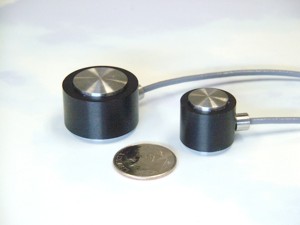Transducer Techniques MLC Miniature Load Cells Offer High Capacity Measurement in Compact Areas

CAL-TEDS Plug & Play Smart Sensors Icon

MLC Series Load Cell Size Comparison

MLC Series Load Cell
These tiny load cells can measure tremendous force in small areas giving engineers more options in the acquisition of force data.
TEMECULA, CALIFORNIA, UNITED STATES, February 22, 2021 /EINPresswire.com/ -- The MLC Series are our miniature high capacity compression load cell\force sensor, featuring low profile compact size for a wide range of portable and dedicated applications up to 30,000 lbs. The load diameter is slightly convex for accurate load distribution. Low deflection thru design results in ultra fast frequency response. This miniature load cell is designed to be mounted in a shallow machined flat surface, either free or fastened via a bottom 6-32 tapped hole. These load cells are manufactured from heat treated 17-4 stainless steel. The sensing element incorporates bonded foil strain g ages to produce a full scale output of 2mV/V. Accuracies are Nonlinearity .25%, Hysteresis .25%, and Nonrepeatability 0.1% or better. Load cells are supplied with a Certificate of Calibration traceable to N.I.S.T.https://www.transducertechniques.com
Transducer Techniques, established in 1979, designs and manufactures a complete line of load cells, torque sensors, special purpose transducers and related instrumentation. Transducer Techniques load cells are uniquely designed for weight and force measurement in such diversified applications as process control and factory automation. Other applications exist in numerous fields of science and industry for our load cells. All transducer sensing elements incorporate bonded foil strain gauges, wired in a full Wheatstone bridge configuration.
Technology
Load cells are electro-mechanical transducers that translate force or weight into voltage. This change in voltage produces a signal in the read-out instrumentation, a repeatable deflection or indication that can be calibrated directly in terms of the load applied to the load cell.
Construction
Construction of the load cell utilizes all the advantages of bonded foil strain gauges. Sealed within the load cell are sets of matched strain gauges bonded to a high strength element, machined to close tolerances. The strain gauges are electrically connected to form a balanced Wheatstone bridge and additional compensation resistors are added to the circuit for maintaining the accuracy of the bridge over a wide temperature range.
Operation
The principle of operation depends upon the deflection of the strain gauge filament, creating a change in its resistance, thereby unbalancing the bridge circuit. As a result, for a given input voltage, the output voltage of the bridge varies proportionally with the load and the change can be read on appropriate instrumentation.
Quality
When completed, each load cell is individually tested and calibrated. Each cell must meet or exceed rigid electrical and mechanical performance tests before it is released for service. Also, every cell is proof tested to its full rated capacity, and in most instances, to over its rated capacity.
Attributes
An important asset of our load cells is their extremely small deflection. The maximum deflection of standard cells does not exceed .012" at full load. This plus the fact that these load cells contain no moving parts opens unlimited application fields. The inherent compactness of the load cells minimizes installation problems.
The frequency response characteristics of our load cells are exceptionally good. The relatively low mass, and the small deflection under load, result in a high-frequency response which emphasizes the use of the load cells in many services where other transducers cannot perform.
Only strain gauges of the highest quality are installed and configured by technicians who have undergone our extensive training program targeting craftsmanship and attention to detail. To the end-user, this means a quality product. All Load Cells / Force Sensors and Torque Sensors are supplied with a Calibration Certificate traceable to NIST.
Customer Support
Transducer Techniques, LLC
+1 800-344-3965
email us here
Visit us on social media:
Facebook
Twitter
Legal Disclaimer:
EIN Presswire provides this news content "as is" without warranty of any kind. We do not accept any responsibility or liability for the accuracy, content, images, videos, licenses, completeness, legality, or reliability of the information contained in this article. If you have any complaints or copyright issues related to this article, kindly contact the author above.
